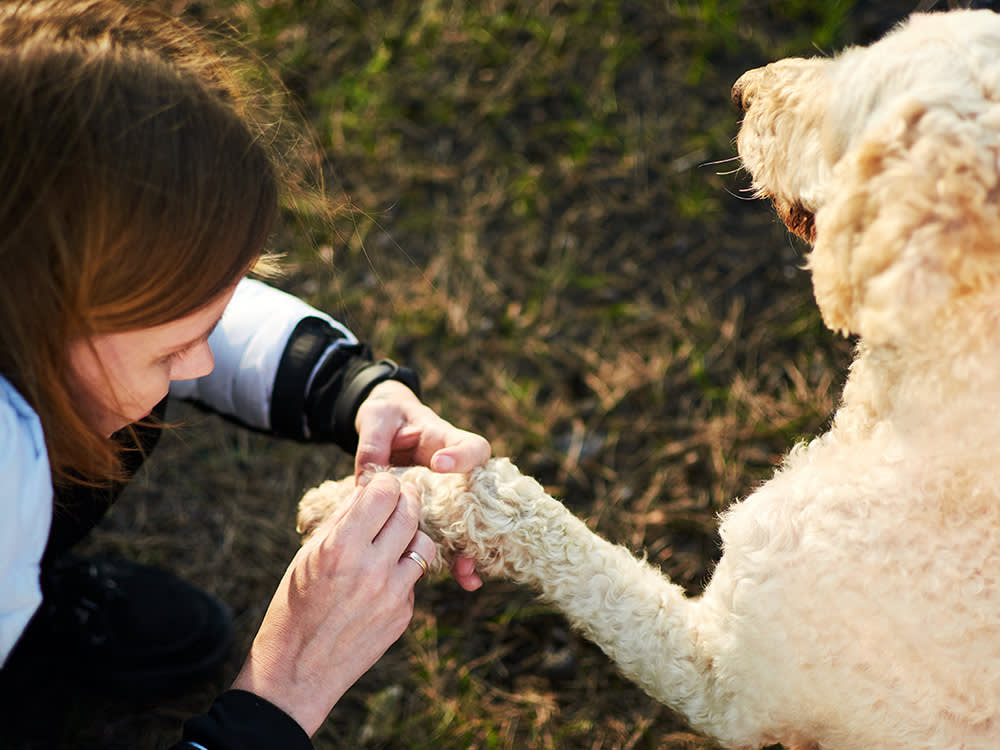Here’s Where Disease-Carrying Ticks Are in the US—And How to Keep Your Pup Safe
Simple preventive steps can go a long way toward offsetting their threats.

Share Article
We’re heading into the warm months, which means ice cream (and pup cones!), vacations, and lots of outdoor time. And, unfortunately, ticks. While rising temperaturesopens in new tab are causing tick populations to expand into new regions (you can now find the pesky arachnids pretty much all over), not all ticks are the same. The United States is home to almost 50 different speciesopens in new tab of ticks, but luckily, they don't all carry diseases.
USA Today recently released a handy mapopens in new tab showing exactly where in the U.S. you can find disease-carrying ticks. Two maps show states where the blacklegged tick (aka deer tick) and Western blacklegged wood tick are located — these are the two ticks responsible for spreading Lyme disease.
Other maps provided by the publication show where you can find the Rocky Mountain wood tick, the American dog tick, and the brown dog tick (all of which spread Rocky Mountain spotted fever); the Gulf Coast tick, which spreads Rickettsia parkeri; and the Lone Star tick, which causes Alpha-gal syndrome.
Below is our breakdown of the disease-carrying ticks to keep an eye on, where you can find them, and how to keep yourself and your pup safe from disease.

Types of ticks and where you can find them
The aggressive lone star tick can transmit ehrlichiosis, one of the most common and dangerous tick-borne diseases in dogs. The lone star tick is found in the Southern and Eastern United States.
The brown dog tick and American dog tick also spread ehrlichiosis, babesiosis, and Rocky Mountain spotted fever (RMSF). The brown dog tick is found throughout the United States; the American dog tick is found everywhere east of the Rocky Mountains, plus along some of the Pacific coast. Dog ticks do not carry Lyme disease.
Then there’s the deer tick. Although there are hundreds of species of ticks — all of which are relatives of spiders and mites, in the U.S. — the deer tick is number-one on the most unwanted list. It spreads several dangerous infections, and topping that list is Lyme disease.
Where Lyme is found, so are deer, but the “deer tick,” as it’s commonly called, is actually the blacklegged tick, and it feeds on many different mammals, birds, and reptiles. The deer tick and the related Western blacklegged tick are the only known transmitters of Lyme disease in the United States. The deer tick is located in the Eastern half of the U.S., and the Western blacklegged tick is found along the Pacific coast.
The trail of infection typically begins with rodents or, in the West, lizards, natural reservoirs of the Lyme bacterium, Borrelia burgdorferi. Ticks need a blood meal to reproduce, and acquire the bacterium when they bite an infected host. The next time they bite an unsuspecting pup or person, they inject the bacterium into their unlucky meal source.
Can ticks make dogs sick?
In parts of the Northeast, up to half of the deer ticks are infected with Lyme disease. In California, where Lyme also exists, the infection rate is far lower, with the disease mainly occurring in four northwestern counties. However, Lyme is only one of the diseases deer ticks spread to dogs; among the others are ehrlichiosis, babesiosis, and anaplasmosis (“dog tick fever”). What are a dog’s chances of getting sick?
Lyme Disease
Lyme disease was first diagnosed in a dog over 25 years ago, and now it’s one of the most common tick-borne diseases in dogs in the U.S., notes Cornell University’s Baker Institute for Animal Healthopens in new tab. In several of the most affected states, one out of 15 dogs tested positive for Lyme disease, according to a study by the Centers for Disease Control and Prevention opens in new tab(CDC).
A dog’s risk goes up and down. As noted on the Baker Institute’s website, even within highly infected regions, there are “hotspots of tick infestation and Lyme disease risk,” which “mingle with non-infested areas with much lower risk.” Even so, far fewer infected dogs than people develop the disease. Studies suggest that more than 75 percent of dogs in hyperendemic areas may be exposed to infected ticks, yet only about five percent develop Lyme.
In fact, even with available tests, diagnosing Lyme disease in dogs is challenging. Unlike viral diseases such as Powassan, Lyme is a bacterial infection and can be treated with antibiotics. But its symptoms, if any, mimic many other diseases. One common sign, lameness, takes two to five months to appear, and, unlike people, dogs don’t develop the telltale bull’s-eye rash around the bite.
Anaplasmosis
Another bacterial infection in dogs caused by ticks is anaplasmosis. This disease is spread by deer ticks (or black-legged ticks) and brown dog ticks. Symptoms of this infection include lameness, joint pain, changes in appetite, diarrhea, vomiting, and lethargy.
Powassan
There’s also a growing list of new diseases involving deer ticks, including one caused by the bacterium Borrelia miyamotoi, which mimics Lyme disease, and the rare but increasing Powassan virus and its variant, deer-tick virus. Powassan hasn’t been found in dogs, but dogs with neurological issues aren’t commonly tested for this rare disease, and such tests aren’t readily available.
Rocky Mountain Spotted Fever
According to the CDCopens in new tab, cases of Rocky Mountain Spotted Fever (RMSF), mainly found in the Southeast, cropped up in an area of eastern Arizona where it had never before been seen — mostly in communities with many free-roaming dogs, who likely carried the brown dog tick. Newer deer tick pathogens are expanding their range, as well. Symptoms of RMSF include poor appetite, abdominal pain, joint pain, fever, coughing, vomiting, diarrhea, swelling on the dog’s face or legs, and depression.
Ehrlichiosis
Ehrlichiosis is one of the many tick-borne infectious diseases that affect dogs. Ehrlichiosis is usually carried by the brown dog tick and is prevalent in the Southeast and Southwest. Common symptoms of ehrlichiosis in dogs include fever, swollen lymph nodes, weight loss, and respiratory problems. But it may also lead to anemia, blindness, and neurological issues.
Where do ticks come from?
Going outdoors is not a problem. What increases the risk of tick bites on dogs is entering tick habitats. Especially if you go in thinking that ticks fall off trees — or that they pounce or fly. Surveys find that most people don’t know enough about ticks and their habits to ward them off. “When it comes to tick-bite protection and disease prevention, we’ve learned that people tend to only focus on it after the fact,” Mather says.
So, do ticks fly or jump?
Ticks can’t fly or jump. Adult ticks, being larger, tend to bump into their hosts. Ticks wait aboard grasses and bushes, closest to the animals’ largest body surface and then simply grab on as a dog passes by. They’re mainly a threat to dogs in fall and early spring. In winter, they only seek hosts when temperatures rise above freezing. Adults also transmit Lyme, babesiosis, and anaplasmosis.
Are nymph ticks dangerous?
“Pet owners seem most [affected] by adult ticks because they can see them,” Mather says, but the nymphs “are potentially more dangerous.” Nymph season is May through August, months during which people and dogs tend to spend the most time outside. Nymphs lurk in moist leaf litter in or near the edge of wooded areas.
Because they’re so tiny at this stage, nymphs attach to small mammals near ground level, such as mice, which often carry Lyme. According to the Baker Institute, only repeated exposure to nymphs causes infection in dogs.
Preventing ticks on dogs
So, the key to successful tick control lies in your own backyard, where about 75 percent of tick bites are said to occur. Even when a tick finds a dog, it has to be embedded for 24 to 48 hours to spread infection; quick removal drastically reduces the risk.
Know the ticks in your area and how to identify their life stages and seasonal patterns.
Take protective actions, such as daily tick checks.
Mow regularly, and remove weeds and leaves.
Make sure garbage and composting containers are rodent-proof.
Remove exotic vegetation or other welcoming habitats.
Paving or laying down gravel in heavily used areas also helps limit tick turf.
BTW, invasive bush honeysuckle and Japanese barberry, for example, attract white-tailed deer and mice (and thus, their ticks). Managing the growth of these plants significantly reduced the abundance of infected ticks.
How to remove ticks from dogs.
To remove a tick, use a fine-tipped tweezer, hold it near the animal’s skin, grasp the tick and pull upwards without twisting. “You should never directly handle or crush a tick with your hands. To dispose of ticks after removal, place them in a sealed bag, flush them down the toilet, wrap them tightly in tape, or immerse them in alcohol. Washing your hands well after removing a tick is a good idea,” says Bruce Kornreich, associate director for education and outreach at the Cornell Feline Health Center.
What about those remedies we learned at camp? Korneich says don’t believe the old tales about using burned matches, nail polish, or Vaseline to kill ticks embedded in a dog’s skin. Removal is a much better idea, and do it as soon as possible because there’s evidence that suggests the longer you wait, the more likely it is your dog will contract a tickborne illness.
References:
Sheila Pell
Sheila Pell is a freelance journalist who frequently writes about environmental issues. Her work has appeared in The Washington Post, Modern Farmer, San Diego Reader, The Bark, and American Forests. She lives in northern California with her husband and two large dogs.

Sio Hornbuckle
Sio Hornbuckle is the Assistant Editor at Kinship, where they frequently write for the site. As a writer, they specialize in pet news, animal science, and pop culture. They live in New York City with their cat, Toni Collette.
Related articles
![Brown Labrador lifting front leg]()
How to Get a Head Start on Your Pet’s Health
Spot lumps, limps, and lethargy early on.
![Australian Shepherd on a hill during golden hour]()
How to Hike Safely With Your Dog This Summer
Time to get your gear—and your pup—ready to go.
![puppy scratching fleas, get rid of fleas on dogs]()
How to Get Rid of Fleas — Proven Home Remedies
You can stop your home from becoming a literal flea circus.
![Tick Tornado product by ZenPet on a blue background surrounding by the green tick removal tools in a dynamic design]()
Adventure Dogs Need a Tick Tornado
This teeny tweezer is more powerful than you think.






